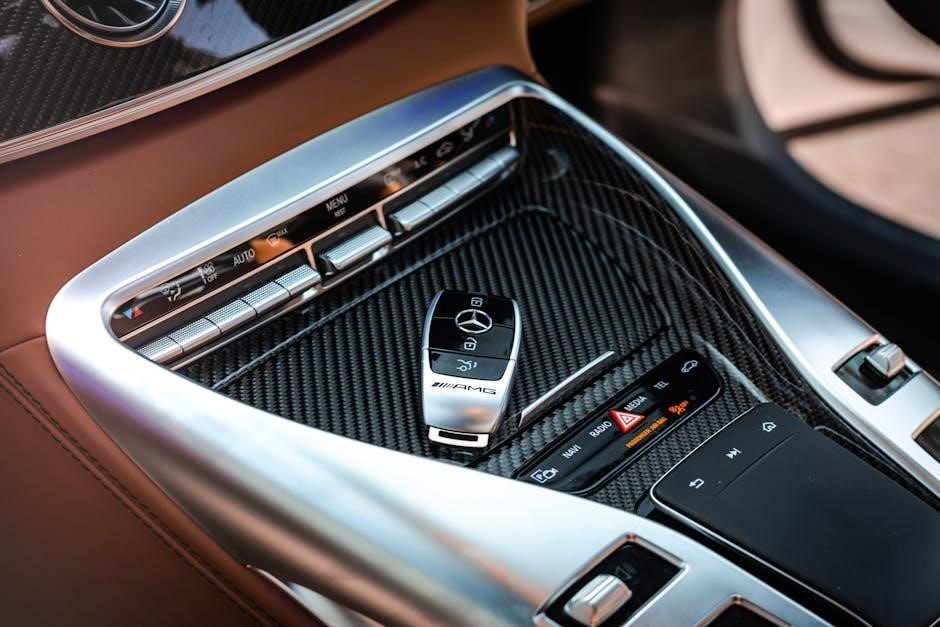The Mitsubishi Lancer Owner’s Manual is a comprehensive guide designed to help owners optimize their vehicle’s performance. It covers essential maintenance, troubleshooting, and operational tips, ensuring a safe and enjoyable driving experience. Available for models from 2011 to 2017, the manual can be downloaded as a PDF for easy access.
Key Features of the Mitsubishi Lancer
The Mitsubishi Lancer is a compact car known for its sporty design and practical features. It offers a range of engine options, including fuel-efficient gasoline engines, ensuring a balance between performance and economy. The Lancer features a spacious interior with premium upholstery options, providing comfort for both drivers and passengers. Advanced technology, such as a touchscreen infotainment system, Bluetooth connectivity, and navigation, enhances the driving experience. Safety is a priority, with features like multiple airbags, anti-lock braking systems (ABS), and electronic stability control. The Lancer also boasts a responsive handling system, making it enjoyable to drive on various road conditions. Optional upgrades, such as alloy wheels and a rear spoiler, add to its aesthetic appeal. The owner’s manual highlights these features, ensuring owners can fully utilize their vehicle’s capabilities. Whether for daily commuting or long trips, the Mitsubishi Lancer is designed to deliver reliability, style, and functionality.
Essential Parts of the Vehicle
The Mitsubishi Lancer features key components such as the engine, transmission, brakes, suspension, and electrical systems. The instrument panel provides vital information, while the steering and fuel systems ensure smooth operation. Regular maintenance of these parts is crucial for optimal performance.
Instrument Panel Overview

The Mitsubishi Lancer’s instrument panel is a central hub designed to provide drivers with essential information at a glance. It features a speedometer, tachometer, fuel gauge, and temperature gauge, ensuring drivers stay informed about their vehicle’s status. The panel also includes warning lights for seat belts, engine malfunctions, low oil pressure, and other critical systems. Additionally, the Multi-Information Display (MID) offers customizable data, such as odometer readings, trip meters, and fuel efficiency. The layout is intuitive, with controls for audio, climate, and navigation systems within easy reach. Understanding the instrument panel’s functions is vital for safe and efficient driving. It is recommended to familiarize yourself with the indicators and controls to make the most of your driving experience and ensure proper vehicle maintenance.
Maintenance Schedule and Servicing

Regular maintenance is crucial for extending the life of your Mitsubishi Lancer. The manual provides detailed service intervals, including oil changes, tire rotations, and fluid checks. Adhering to these schedules ensures optimal performance and prevents potential issues.
Recommended Service Intervals
The Mitsubishi Lancer Owner’s Manual outlines specific service intervals to ensure your vehicle runs efficiently and reliably. Routine maintenance, such as oil changes, is recommended every 5,000 to 7,500 miles, depending on driving conditions. Tire rotations should occur every 7,500 miles to maintain even wear and improve safety. Brake fluid and coolant checks are advised every 30,000 miles, while spark plug replacement is typically needed at 100,000 miles. The manual also emphasizes the importance of inspecting air filters every 15,000 miles and replacing them as necessary. Additionally, the timing belt should be replaced at 105,000 miles to prevent engine damage. Adhering to these intervals helps maintain performance, prevents costly repairs, and ensures your vehicle remains under warranty. For precise scheduling, consult the manual or contact a certified Mitsubishi service center. Regular servicing not only prolongs your car’s lifespan but also enhances its overall driving experience. By following these guidelines, you can keep your Mitsubishi Lancer in optimal condition for years to come.

Maximizing Fuel Efficiency
Maintain proper tire pressure, drive at moderate speeds, and use cruise control to optimize fuel efficiency. Avoid aggressive acceleration and ensure regular maintenance, such as air filter checks, to enhance your Mitsubishi Lancer’s mileage and performance.
Driving Techniques for Better Mileage

Adopting efficient driving habits can significantly improve your Mitsubishi Lancer’s fuel economy. Maintain consistent speeds and avoid sudden acceleration or hard braking, as these can lower mileage. Use cruise control on highways to keep a steady pace and reduce fuel consumption. Additionally, remove unnecessary weight from the vehicle, as excess cargo can decrease efficiency. Keep windows closed at high speeds to minimize drag and use air conditioning sparingly, as it can increase fuel usage. Plan your route to avoid traffic congestion and construction delays, which can lead to idling and wasted fuel. Regularly check tire pressure, as under-inflated tires can reduce mileage. By combining these techniques, you can maximize your Lancer’s performance while saving on fuel costs.
- Maintain moderate speeds and avoid aggressive driving.
- Use cruise control on long drives.
- Remove unnecessary weight from the vehicle.
- Minimize idling and avoid heavy traffic.
- Check tire pressure regularly for optimal efficiency.
These simple adjustments can make a noticeable difference in your Mitsubishi Lancer’s fuel efficiency.

Troubleshooting Common Issues
Identify common symptoms like warning lights, unusual noises, or reduced performance. Consult the manual for diagnostic guidance. Address issues promptly to prevent further damage. Regular checks and professional servicing can resolve most problems effectively.
Identifying Common Symptoms
Recognizing common issues early can prevent major repairs. Check for warning lights on the dashboard, such as the check engine light or oil pressure alerts. Unusual noises, like grinding or rattling sounds, may indicate worn brakes or engine problems. Performance issues, such as poor acceleration or rough idling, could signal problems with the fuel system or ignition. Additionally, vibrations while driving or difficulty shifting gears may point to transmission or suspension issues. Strange odors, such as burning smells, could indicate overheating or electrical problems. Refer to the manual for guidance on interpreting these symptoms. Regular inspections and addressing issues promptly can help maintain your Mitsubishi Lancer’s reliability and performance. Always consult the manual or contact a professional if unsure about the cause of a symptom.
Warranty and Service Coverage
The Mitsubishi Lancer comes with a comprehensive warranty and service coverage plan designed to protect your investment. The warranty typically includes a new vehicle limited warranty, covering parts and labor for a specified period or mileage, along with a powertrain warranty for extended coverage on key components. Additionally, corrosion perforation coverage is provided to ensure the vehicle’s body and frame remain durable. Regular servicing is essential to maintain warranty validity, so always adhere to the recommended maintenance schedule outlined in the manual. Mitsubishi also offers roadside assistance programs for added peace of mind, covering towing, battery jumps, and fuel delivery. For further support, Mitsubishi provides dedicated customer service and online resources to address any questions or concerns. By following the guidelines in the manual, you can ensure your Mitsubishi Lancer remains in optimal condition and its warranty remains intact. Proper maintenance not only extends the vehicle’s lifespan but also enhances its performance and reliability.

Downloading the Mitsubishi Lancer Owner’s Manual
Downloading the Mitsubishi Lancer Owner’s Manual is a straightforward process that provides instant access to essential information about your vehicle. The manual is available in PDF format for models from 2011 to 2017 and can be downloaded from various online sources, including official Mitsubishi websites and trusted third-party databases. To find the correct manual for your vehicle, visit websites like ownersmanuals2.com or Mitsubishi Motors, where you can search by model year and download the manual for free. Once downloaded, you can print the manual or save it to your device for easy reference. The PDF format ensures that the manual is easily searchable and accessible on both desktop and mobile devices. By downloading the manual, you can avoid the hassle of physical storage and ensure you always have the information you need to maintain and operate your Mitsubishi Lancer effectively. This convenient option is both eco-friendly and practical, providing peace of mind for years to come.
The Mitsubishi Lancer Owner’s Manual is an indispensable resource for every vehicle owner, offering detailed insights into maintenance, operation, and troubleshooting. By following the guidelines outlined in the manual, drivers can ensure their Lancer performs optimally, maintains its longevity, and remains safe to drive. Regular servicing, adherence to recommended schedules, and proactive care are key to preserving the vehicle’s condition. Additionally, understanding the manual’s instructions can enhance fuel efficiency and overall driving satisfaction. Always refer to the manual before attempting any repairs or adjustments to avoid potential damage. For the best experience, keep the manual handy, whether in print or digital form, and familiarize yourself with its contents. By doing so, you’ll be well-equipped to handle routine maintenance and unexpected issues alike, ensuring your Mitsubishi Lancer continues to deliver reliable performance for years to come.




































































